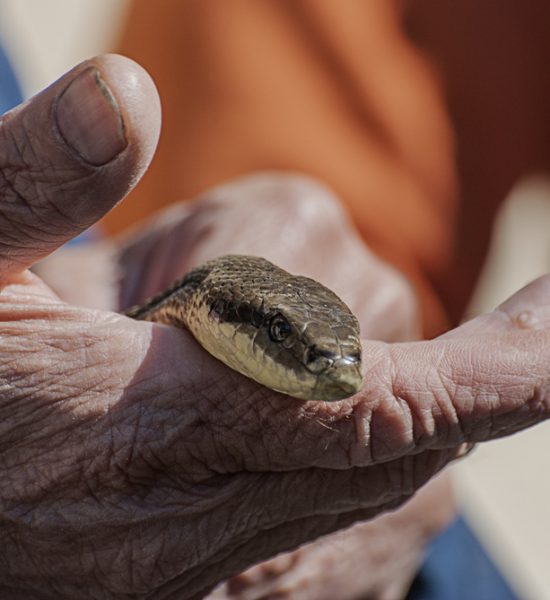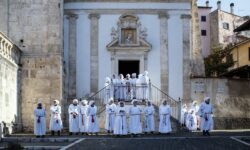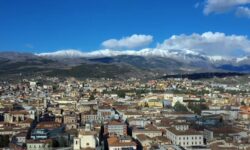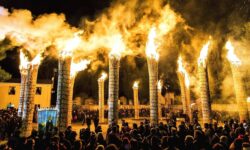Cocullo is a small medieval town with a population of 200 people in the Province of L’Aquila, just over an hour from Rome and 40 minutes from Pescara. Perched on a rocky hilltop, it is surrounded by wild rugged beauty, national parks and nature reserves. Every year, on May 1, up to 30,000 pilgrims – along with the curious, academics, and journalists from all over the world – gather to watch the Festa dei Serpari, a procession of snake catchers, a rite that has remained unchanged for many centuries.
Festival
The origins of the festival have been obscured by time. Valter Chiocchio from Pro Loco di Cocullo, a volunteer, grass-roots group, which organises the festival, explains: “How long and why this tradition exists in Cocullo is still unclear. It goes so far back in time that we haven’t yet managed to find the starting point.”
According to some historians, the festival has strong pagan roots connected to the times when, almost 3,000 years ago, on spring’s arrival, local Italic tribes offered live snakes to appease Angitia, the ancient goddess of snakes and healing. Later, around the 11th century, Christians adapted the ritual to honour San Domenico.
The town’s patron saint, San Domenico, was believed to protect people from the bites of poisonous snakes and rabid animals. In Cocullo, two relics are kept in the main church: the saint’s molar tooth and his mule’s iron shoe. All year round, the faithful pray to San Domenico, but on May 1, the worship becomes an open-air spectacle.
Since 2009, the services of the patronal feast of San Domenico have been held in the small church of Maria delle Grazie, on the town’s main piazza because the Chiesa di San Domenico, due to bureaucratic delays, is still closed after the L’Aquila earthquake. In the past, on the morning of the festival, parishioners took turns to pull a rope with their teeth to ring the bell in the belief that it will protect them from toothache all year. Then they formed a line to take a handful of blessed soil from the cavern behind the saint’s statue, which they keep in their homes as a protection from evil, sprinkle in agricultural fields to keep poisonous snakes away or dissolve in water and drunk as a remedy against fever. These ancient traditions have been paused at the moment while waiting for the church of San Domenico to be restored.

In the afternoon, four parishioners bring the wooden statue of San Domenico outside the church on the main piazza, where local snake catchers, as a gift to the saint, “dress” it with the most beautiful live snakes they could find, some up to two metres long. The procession goes through the streets of the town’s historic centre, densely packed with spectators.
Snakes and catchers
Before the procession, the snake catchers (serpari), stand in the square in front of the church, proudly showing off their snakes. The curious gather around. For many visitors, it is the only time in their lives that they dare come so close to the much-feared reptiles. Some not dare touch them, others brave selfies with serpents wrapped around their neck or hands.
The snakes used for the festival are docile and non-venomous. Skilful local snake catchers begin collecting snakes when the first spring thaw arrives, around March 19. They catch five different types of harmless reptiles: the four-lined snake (cervone), Aesculapian snake (saettone), grass snake (biscia dal collare), green whip snake (biacco) and, sometimes, the rare smooth snake (colubro liscio). They are treated with respect and fed boiled eggs and live mice.
The day after the festival, the reptiles are released back in nature, to the locations where they were captured. Each snake catcher has secret places and know all the slithery creatures’ nests and burrows there. They say that snakes are territorial and do not move more than a few kilometres during their lives.

“What is unusual for others, is normal for us”
That’s what locals say about their close relationship with reptiles. It is an ordinary thing for local children to learn the skills of serpari from a young age. “Serpari could be old and young people, men and women,” explains Valter Chiocchio. “They start when they are kids, learning from their father’s snakes’ behaviour, the capture techniques and how not to harm them.”
One thing that has changed over the years is respect and care towards the snakes, which are now protected by law. Today they are kept in custom-made heated terrariums until their release. The local town hall, with the help of two herpetologists, runs a conservation project which, thanks to the data collected every year by Cocullo’s local snake catchers, is unique in the world.

*********************************************************************************************
If you go
Make sure to arrive early on the day of the festival, at 8-8.30am as there will be long queues at the motorway exit from mid-morning. TrenItalia add new trains and stops for the festival (you can see the timetable on their website). The train station is 800 metres from the town’s main piazza.
When you visit Cocullo, start at the Town Hall (Piazza Madonna delle Grazie, 1) and see the permanent multi-media exhibition dedicated to the Feast of San Domenico. You can see photos of the religious rites and the procession, learn about local snakes, and watch documentaries about the festival produced by broadcasters in Italy and Europe. The exhibition also has an extensive library of studies and books on folk traditions in Abruzzo and an archive of historical documents and records of events in Cocullo over the centuries.
Guided tours in English can be booked by emailing info@associazionedinolacocullo.it or calling 39 3486111536. For group tours of Cocullo (excluding the festival day) contact Pro Loco di Cocullo at prolocococullo@hotmail.it.
*********************************************************************************************
For more about the festival go to www.coculloproloco.it.
Photos are courtesy of Pro Loco di Cocullo.
Jolanda Ferrara is an Abruzzo-based Italian journalist, who
writes for a number of regional publications about food, wine and
culture.





